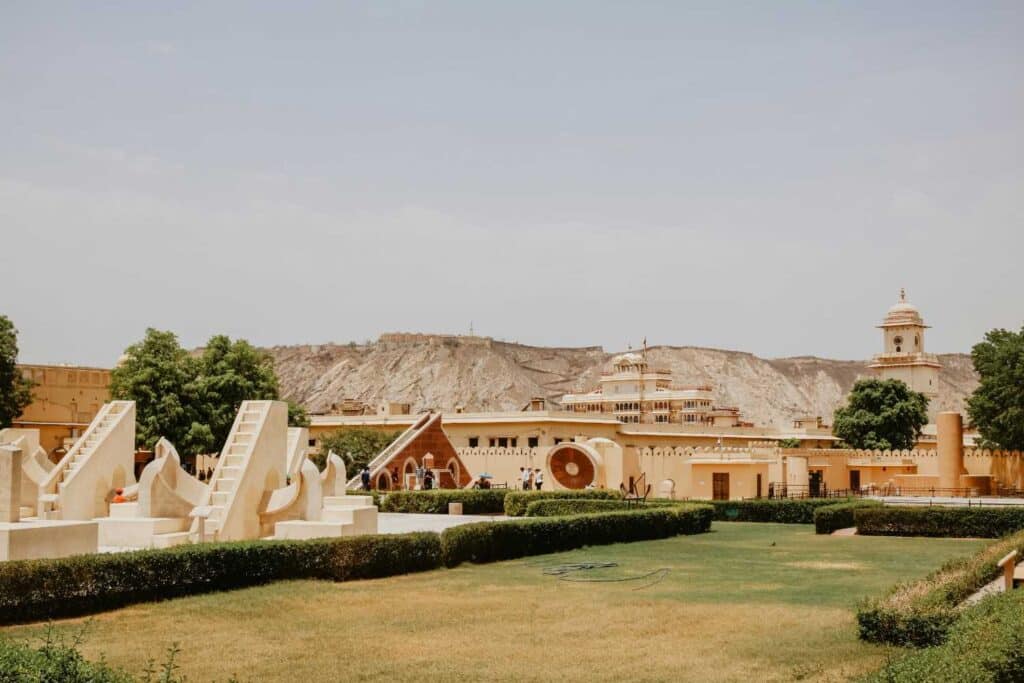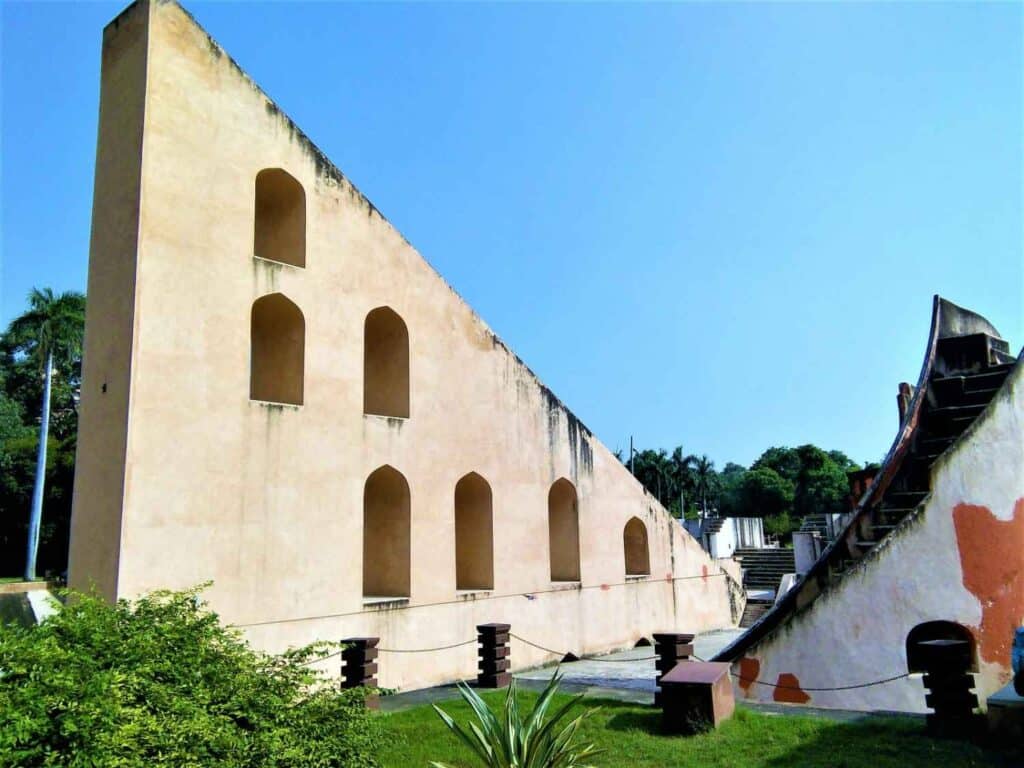
The Jantar Mantar in Jaipur, a UNESCO World Heritage Site, stands as a testament to India’s rich history in astronomy and scientific innovation. Located in the heart of the Pink City, this 18th-century observatory is one of the largest and best-preserved examples of its kind in the world. Built by Maharaja Sawai Jai Singh II between 1724 and 1734, it is a unique blend of architectural brilliance and scientific expertise.
In this article, we delve into the history, architecture, and significance of the Jantar Mantar, highlighting why this site remains a must-visit for history enthusiasts, science lovers, and travelers alike.
The Historical Significance of Jantar Mantar
Maharaja Sawai Jai Singh II, the founder of Jaipur, was not only a ruler but also an avid astronomer. He built five Jantar Mantars across India, including those in Delhi, Ujjain, Mathura, and Varanasi, but the Jaipur Jantar Mantar is the largest and most intricate. The primary purpose of this observatory was to aid in the precise calculation of time, predict celestial events, and map astronomical data for both scientific and astrological purposes.
The construction of Jantar Mantar was inspired by ancient Indian and Islamic astronomy, combined with the influence of European advancements in the field. It showcases the remarkable foresight of a ruler who understood the importance of science in governance and daily life.
Architectural Grandeur and Design

Spread across an area of nearly 18,700 square meters, the Jantar Mantar Jaipur features 19 astronomical instruments, each with a unique function. The site is constructed using local marble and sandstone, ensuring durability while maintaining aesthetic appeal. The instruments are not only functional but also beautifully crafted, reflecting the expertise of the artisans of the era.
Key Instruments at Jantar Mantar
- Samrat Yantra
Known as the Supreme Instrument, the Samrat Yantra is a massive sundial that stands at 27 meters tall. It is capable of measuring time to an accuracy of two seconds. This sundial is an engineering marvel, with its shadow moving at a discernible pace, allowing visitors to witness timekeeping in its purest form. - Jaiprakash Yantra
The Jai Prakash Yantra consists of two concave hemispherical structures with markings on the inner surfaces. These instruments were used to determine the coordinates of celestial bodies and assist in astronomical calculations. - Rashi Valaya Yantra
A set of twelve instruments, the Rashi Valaya Yantra represents the twelve zodiac signs. Each instrument is dedicated to a specific zodiac and is used to study the celestial positions and their astrological significance. - Chakra Yantra
The Chakra Yantra is used to measure the declination of celestial bodies and locate the meridian pass of planets and stars. - Narivalaya Yantra
This instrument is designed with two dials, one for the northern hemisphere and the other for the southern hemisphere. It is used to track the movement of celestial bodies in both hemispheres.
The Scientific Legacy of Jantar Mantar
The Jantar Mantar of Jaipur is not merely a historical monument but a testament to India’s scientific acumen during the 18th century. It demonstrates how astronomy was deeply interwoven with daily life, influencing everything from agricultural planning to religious ceremonies.
The precision with which these instruments were designed and constructed is remarkable, considering the limited technological resources of the time. The observatory continues to be a source of inspiration for modern astronomers and scientists.
Visiting Jantar Mantar: What to Expect
Location and Accessibility
Situated near the City Palace and the iconic Hawa Mahal, Jantar Mantar is easily accessible from any part of Jaipur. Its central location makes it a convenient stop for tourists exploring the rich heritage of the Pink City.
Entry Timings and Fees
- Timings: The observatory is open daily from 9:00 AM to 5:00 PM.
- Entry Fees: The ticket prices are nominal, with special discounts for students and children. Visitors can also opt for a composite ticket that includes access to other nearby attractions.
Best Time to Visit
The ideal time to visit Jantar Mantar is during the cooler months, from October to March, when the weather in Jaipur is pleasant. Early mornings or late afternoons provide the best lighting conditions for photography and exploring the instruments without the crowds.
Guided Tours
Hiring a local guide or opting for an audio guide can greatly enhance your experience. The detailed explanations about each instrument, its purpose, and its historical significance bring the site to life, offering a deeper appreciation of its scientific marvels.
UNESCO World Heritage Status
In 2010, Jantar Mantar Jaipur was inscribed as a UNESCO World Heritage Site, recognizing its cultural and scientific significance. The observatory was lauded for its ability to illustrate the cosmological concepts of the time through monumental instruments.
This recognition has further cemented its status as a global heritage site and attracted scholars and tourists from across the world.
Why Jantar Mantar is a Must-Visit
- Historical Importance: It provides a glimpse into India’s rich astronomical heritage.
- Scientific Innovation: The instruments showcase remarkable precision and ingenuity.
- Architectural Beauty: The fusion of functionality and aesthetics is unparalleled.
- Cultural Significance: It reflects the advanced knowledge of ancient Indian astronomers.
Tips for a Memorable Visit
- Plan Ahead: Combine your visit to Jantar Mantar with nearby attractions like the City Palace and Hawa Mahal for a comprehensive heritage experience.
- Stay Hydrated: Carry water bottles, especially during the summer months.
- Photography: Capture the intricate details of the instruments, but be mindful of preserving the heritage site.
- Engage with History: Take the time to understand the purpose of each instrument for a more enriching experience.
Conclusion
The Jantar Mantar in Jaipur stands as a magnificent blend of art, science, and history. It is a tribute to the intellectual curiosity and ingenuity of its time. Whether you are a science enthusiast, history buff, or simply a traveler seeking unique experiences, this observatory offers something for everyone.
Embark on a journey through time and space by visiting Jantar Mantar, where the past meets the cosmos in a symphony of architectural and scientific brilliance.
1. What is the historical significance of Jantar Mantar in Jaipur?
Jantar Mantar in Jaipur is a UNESCO World Heritage Site built by Maharaja Sawai Jai Singh II in 1734. It is an astronomical observatory that showcases India’s advancements in science and architecture during the 18th century. The site consists of 19 large instruments designed to measure time, predict eclipses, track celestial bodies, and determine planetary positions. It is a testament to the Maharaja’s passion for astronomy and his contributions to ancient observational science.
2. How can I reach Jantar Mantar, Jaipur, from the city center?
Jantar Mantar is centrally located in Jaipur, near the City Palace and Hawa Mahal.
By Auto-rickshaw or Taxi: Easily accessible from any part of Jaipur within 15–30 minutes.
By Bus: Public buses heading towards the City Palace or Hawa Mahal will drop you nearby.
By Walking: If you are near the city center, it’s a short walk from prominent landmarks like Johari Bazaar.
3. What are the entry fees and timings for visiting Jantar Mantar?
Entry Fees:
Indian Nationals: ₹50 per person
Foreign Nationals: ₹200 per person
Students (with ID): ₹15 (Indian) / ₹100 (Foreign)
Timings: Open daily from 9:00 AM to 5:00 PM.
Note: Visiting during daylight hours is best for observing the instruments.
4. What unique instruments can be seen at Jantar Mantar, Jaipur?
Samrat Yantra: The world’s largest sundial that provides accurate time within 2 seconds.
Jai Prakash Yantra: A concave hemisphere used to determine the positions of stars.
Rama Yantra: Measures altitudes and azimuths of celestial objects.
Chakra Yantra: Calculates the coordinates of celestial bodies.
Rashi Valaya Yantra: Tracks the zodiac signs.
These instruments reflect the advanced astronomical knowledge of ancient India.
5. Is Jantar Mantar, Jaipur, suitable for a family visit, including kids?
Yes, Jantar Mantar is an educational and interactive experience for families. Children can learn about astronomy, time measurement, and ancient scientific methods in an engaging way. However, younger kids may need additional explanations to understand the instruments. The open-air design provides ample space for family exploration.
6. Are guided tours available at Jantar Mantar, and what languages are supported?
Yes, guided tours are available.
Languages Supported: English, Hindi, and other regional languages.
Options: You can hire government-approved guides or use audio guides available at the site. Guides help explain the complex workings of the instruments in simple terms, enhancing your visit
7. What is the best time of year to visit Jantar Mantar in Jaipur?
The best time to visit is during the winter months (October to March) when the weather is pleasant for outdoor exploration. Visiting in the early morning or late afternoon ensures comfortable temperatures and good lighting for photography.
8. How does Jantar Mantar contribute to our understanding of astronomy?
Jantar Mantar showcases the scientific expertise of ancient India. It demonstrates how people accurately measured time, predicted celestial events, and tracked astronomical phenomena without modern tools. Its design reflects the perfect blend of science, architecture, and mathematics, providing valuable insights into observational astronomy and heritage.
9. Are there any nearby attractions to visit after exploring Jantar Mantar, Jaipur?
Yes, several attractions are within walking distance:
City Palace (500 meters): A beautiful blend of Mughal and Rajput architecture.
Hawa Mahal (700 meters): The iconic “Palace of Winds.”
Albert Hall Museum (3 km): The oldest museum in Rajasthan.
Johari Bazaar (1 km): A vibrant market for traditional jewelry and textiles.
10. What are the best photography spots at Jantar Mantar, Jaipur?
Samrat Yantra: Capture its massive structure against the sky.
Jai Prakash Yantra: Great for symmetrical shots inside the instrument.
Panoramic Views: Wide-angle shots of multiple instruments together.
Evening Golden Hour: The light enhances the textures and colors of the sandstone and marble.